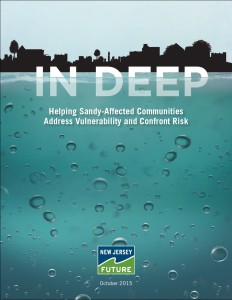In Deep: Helping Sandy-Affected Communities Address Vulnerability and Confront Risk
 This report examines the origin and outcomes of a groundbreaking approach to helping communities take steps to make themselves more resilient to natural disasters. The approach, based on FEMA’s recommended National Disaster Recovery Framework, was piloted by New Jersey Future in six Sandy-affected communities. The report summarizes the lessons learned from those engagements, and discusses recommendations for replicating the approach effectively in other post-disaster situations.
This report examines the origin and outcomes of a groundbreaking approach to helping communities take steps to make themselves more resilient to natural disasters. The approach, based on FEMA’s recommended National Disaster Recovery Framework, was piloted by New Jersey Future in six Sandy-affected communities. The report summarizes the lessons learned from those engagements, and discusses recommendations for replicating the approach effectively in other post-disaster situations.
The pilot program involved placing local recovery planning managers (LRPMs) in selected municipalities to assist with short-term recovery, to help evaluate offers of post-disaster assistance, to secure additional resources, and to facilitate decision-making to increase long-term resiliency. These professionals were made available at no cost to the participating towns, through funding from the Merck Foundation and the New Jersey Recovery Fund.
The report documents how decisions were made about which towns should be part of the pilot LRPM program and the commitments they needed to make; what steps needed to be taken in order to ensure that both residents and local officials could trust the leadership of the LRPMs and engage in a robust change process; and how the program approached the difficult tension between increased long-term financial risk and the urgent need to rebuild an area heavily economically dependent on its geography.
Results to date from the six towns indicate that the approach is effective for both assisting local governments with immediate recovery needs and engaging the community and local elected officials in critical decision-making about risk and vulnerability. The keys to achieving results include working hand-in-hand with local officials over an extended period of time; explaining clearly the financial risk to both property owners and municipalities of assets that are left in harm’s way; and ensuring that as broad as possible a cross-section of the affected community can participate in the ensuing discussions.
Recommendations in the report cover how best to implement a similar program in other communities, and how to align state and federal rebuilding policies with local resilience goals. But perhaps the biggest recommendation in the report is that sufficient funds should be allocated to expand the program, both to more affected towns and to allow LRPMs to stay embedded for longer than the two years that current funding has allowed. A longer engagement would allow the risk-based conversations to mature and result in specific strategies that will affect current and future residents. Allocating more post-disaster aid money to local long-term planning would facilitate this expansion, and, based on this pilot implementation, would enable recipients to make themselves less vulnerable to future disasters, thus potentially reducing their need for post-disaster aid.
Download In Deep: Helping Sandy-Affected Communities Address Vulnerability and Confront Risk
Related Documents
- Resolution of Engagement template
- Memorandum of Agreement template
- Scope of Services sample
- Strategic Recovery Planning Report sample (includes Getting to Resilience report and vulnerability analysis)
- Vulnerability analysis presentation sample (Powerpoint)
- New Jersey Future letter/comments on CDBG-DR plan, March 2013
- New Jersey Future statement on Sandy Recovery Action Plan, April 2013
- Local Recovery Planning Manager program planning needs description, May 2013
- Local Recovery Planning Manager program recommendation on unmet needs, December 2013
- New Jersey Future Testimony on Sandy Recovery Action Plan Amendment, February 2014
- Joint letter on Sandy Recovery Action Plan Amendment 7 re resiliency, March 2014
- Joint letter on Sandy Recovery Action Plan Amendment 7 re planning, March 2014
- New Jersey Future comments on draft state Hazard Mitigation Plan, April 2014
For more information and resources on rebuilding a resilient Shore, please see our Rebuilding for Resiliency page.











